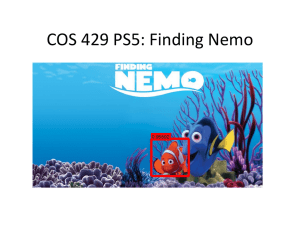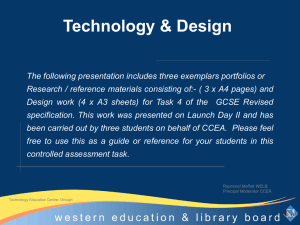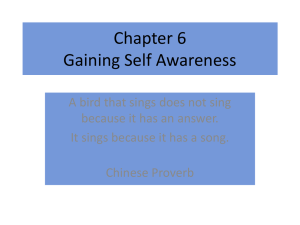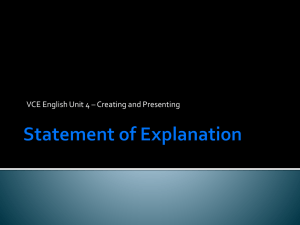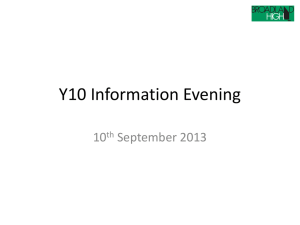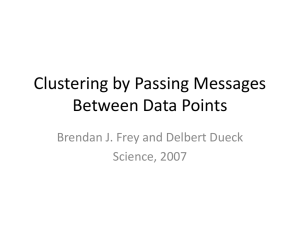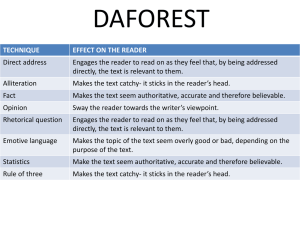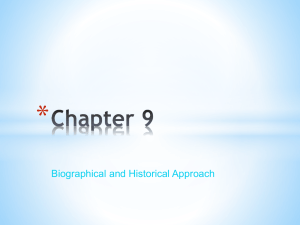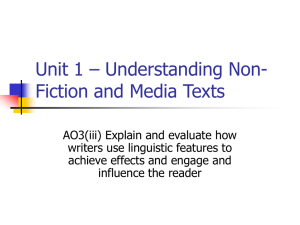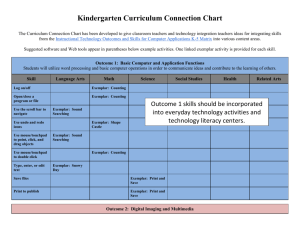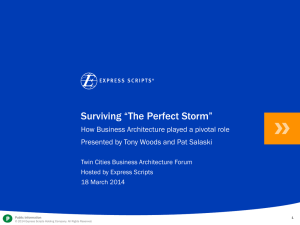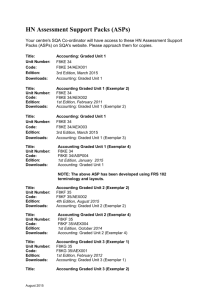Writing - NISPLAN
advertisement
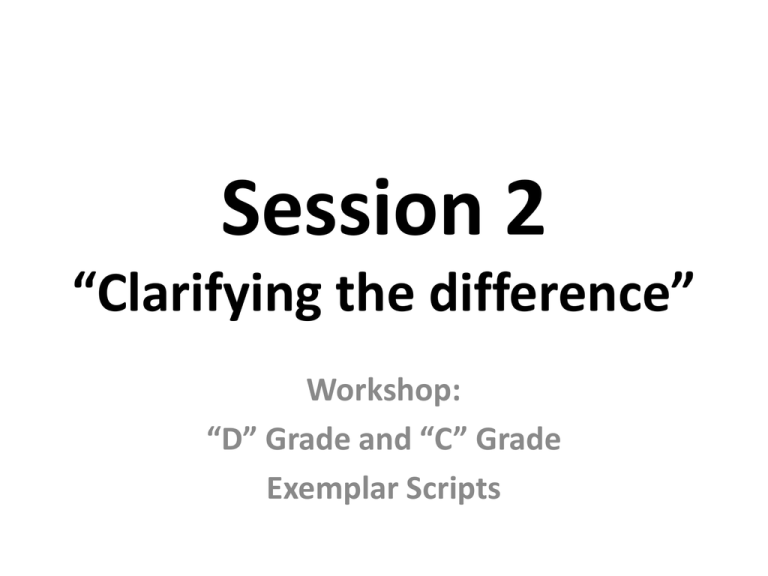
Session 2 “Clarifying the difference” Workshop: “D” Grade and “C” Grade Exemplar Scripts Exemplar Scripts • Personal Writing: –“C” Standard Response • What are the characteristics of a “C” grade in writing? Exemplar Scripts • Personal Writing: –“D” Standard Response • What are the characteristics of a “D” grade in writing? Exemplar Scripts • Reading Multi-modal Texts: –“C” Standard Response • What are the characteristics of a “C” grade in reading? Exemplar Scripts • Reading Multi-modal Texts: –“D” Standard Response • What are the characteristics of a “D” grade in reading? Exemplar Scripts • Functional Writing: –“C” Standard Response • What are the characteristics of a “C” grade in writing? Exemplar Scripts • Functional Writing: –“D” Standard Response • What are the characteristics of a “D” grade in writing? Exemplar Scripts • Reading Non-fiction Texts: –“C” Standard Response • What are the characteristics of a “C” grade in reading? Exemplar Scripts • Reading Non-fiction Texts: –“D” Standard Response • What are the characteristics of a “D” grade in reading? Writing: “C” Candidates • Begin to engage and sustain readers • Use a style that suits audience and purpose • Liveliness • Evidence of structure • A good grasp of paragraphing Writing: “C” Candidates • Paragraphs linked – use of discourse markers/connectives to enhance organisation • Use sentence variety • Clear selection of vocabulary for effect • Selection of detail to describe • Range of rhetorical devices used • Control and accuracy of language used • Basic punctuation is correct and routinely used Writing: “D” Candidates • Write in sentences that read like they speak – a bit too long and too often with ideas joined by ‘and’ and ‘but’ or ‘so’ • Use the first word that comes into their head rather than rejecting it and fishing around in their head for a more precise or unusual one • Aren’t vivid enough: they don’t help the reader to see, hear and smell the things they describe Writing: “D” Candidates • Use commas to join sentences – instead of full stops between sentences • Use certain words too often: ‘I’/ ‘was/were’/ ‘it’ • Start too many sentences with ‘Then’/ ‘There are’/ ‘It was’/ ‘I am’ • Lack variety in sentence structure • Are a bit predictable • Often run out of time Reading: “C” Candidates • Structured and organised response • On task from start to finish • Focus on bullet points – Words and phrases/structure/facts and opinion • Use Point/ Explain/ Evidence – the whole way • Precision of focus and explanation • Analysis ranges through the text/s • Provide a range of examples • An evaluative approach • Don’t report Reading: “D” Candidates • “Feature spot” - say WHAT is happening in the text but don’t say enough about HOW it is written. • Make general statements about language and pres. devices • Attempt to analyse but analysis tends to be straight-forward • Don’t comment enough on language (structure, sentences, words) Reading: “D” Candidates • Don’t provide examples/evidence • They use quotes from the text that are too long • Sometimes use PEE – but not sustained throughout • Evidence of reporting • Not always focused on task • Often run out of time Session 4 Teaching Strategies: Moving from D to C Starter Activity http://resources.woodlandsjunior.kent.sch.uk/maths/co untdown/ Some Teaching Strategies!! Hard work!!! What schools are doing? 1. 2. 3. 4. After school classes Lunch-time classes Cancelled study leave Bring back students during study leave to do workshops on English 5. KS3 SoW as prep for GCSE 6. Signature teacher Reading Guided Reading • A small group of ‘D’ students (up to max. 6 students) • Once a week for 15 to 20 minutes (or once every two weeks) on aspects of reading when the rest of the class are doing independent work – – – – exemplar scripts past papers multimodal texts non-fiction texts, etc • Because of the limited time you may only work on one or two aspects of a text or part of a text. “Feature Spotting” • Do not “feature spot”!!! • “The writer uses alliteration.” - this is not enough to get you a “C” grade • “The writer uses alliteration. So the reader's attention is drawn to these words.” – still not enough to get you a “C” grade • You need to explain why these particular words are singled out for attention. What's special about these words? Why these words and not some other words? 2 most important words • Now for the TOP Tip: I want you to hear the following two most important words in your head: So What? • “The writer uses alliteration.” So what? • “The writer uses alliteration. So the reader's attention is drawn to these words.” So what? • The writer uses alliteration to emphasize the words 'perverse', 'painful' and 'pointless'. By highlighting the idea that experiments on animals are 'perverse' the writer is suggesting to the reader that there is actually something morally wrong with what the experimenters are doing … • The writer uses the alliteration “luscious lemons”. The word “luscious” is emphasised and suggests the lemons have a pleasingly rich and delicious taste. • The pictures help show the reader what is being written about. If you want people to complain about animal testing, it helps to show images of the animals. They have shown them looking as if they are suffering, to create a sense of pity in the reader. They have contrasted this with pictures of the animals roaming free, to suggest what life is supposed to be like for these animals. Writing Making pupils write, who do not like to write, write more, will not make them write better!!!! Guided Writing • A small group of ‘D’ students (up to max. 6 students) • Once a week for 15 to 20 minutes (or once every two weeks) on aspects of writing when the rest of the class are doing independent work – exemplar scripts – past papers – descriptive writing – introductions – conclusions – structure – developing an argument, etc – spelling, punctuation and grammar • You might only focus on one (or two) aspects of writing. • You might focus on a piece of writing completed by a pupil in the group as a resource to use with the rest of the group. A sequence for teaching writing 1. Establish clear aims 2. Provide examples 3. Explore the features 4. Define the conventions 5. Demonstrate how it is written 6. Compose together 7. Scaffold first attempts 8. Independent writing 9. Draw out key learning 10.Review The Writing Process Talk and Writing Talk encourages children to generate and rehearse appropriate language as they work collaboratively to plan, draft and improve their writing. • • • • before writing during writing after writing in whole-class and in group/ guided sessions Spelling Test!! Answers 1. 2. 3. 4. 5. 6. 7. 8. 9. 10. 11. 12. desiccate ecstasy millennium dumbbell separate necessary peddler/pedlar minuscule/miniscule address accommodate irresistible liaison 13. 14. 15. 16. 17. 18. 19. 20. 21. 22. 23. 24. harass definitely occurrence embarrass pronunciation independent questionnaire weird broccoli referring recommend cemetery Spelling Strategy Activity There are 3 easy ways to improve your spelling Demystify Spelling 1. What words look like 2. What words sound like 3. Connections See Be-lie-ve Bu-sin-ess Se-para-te Envi-ron-ment Hear Govern+ment Feb-RU-ary Happen+ed Sur+prise Interesting Connections necessary rhythm because sep-a-rat-e www.freerice.com Video Starter Website www.literacyshed.com Student Self-Evaluation • To achieve a Grade ‘C’ the students will need to be confident in all the aspects reading and writing identified in the survey. • Green/Orange/Red Code – help the ‘D’ students identify and then focus on areas of weakness • Tips on how to improve

